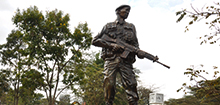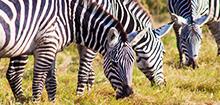GENERAL REQUIREMENTS FOR CARE OF SNAKES
- The enclosures/cages should simulate the snake’s natural environment/habitat.
- Appropriate cage size is very important especially for breeding to avoid overcrowding. Cage size should be dependent on the species habits e.g. arboreal species like boomslang require large preferably walk-in cages.
- The cages should be relatively big for most of the species and supplied with substrate material
- Non-poisonous snakes e.g. sand & green bush snakes, need not be kept in cages but in open enclosures.
- The cage should be according to the acceptable standard or type. The cage material is very important for security and welfare of the species themselves. Use of wire mesh should be avoided as it can hurt the species. Glass cages are more preferable.
- Cleanliness of cages/enclosures/pens is paramount.
- Living conditions- maintenance and care standards e.g. feeding, non-medical care and cleaning of holding cages should be well established. Frequency of cage cleaning should balance between the level of cleanliness necessary to prevent diseases and the amount of stress imposed by frequent handling and exposure of the animal to unfamiliar surrounding and bedding.
- Housing will vary depending on the biological needs of the species and the purpose of the operation. Normal housing should incorporate, as far as possible, those aspects of natural habitat deemed fit for the survival and well- being of the animal. The environment must include features such as natural materials, refuges, perches, and water baths. Natural foods, light and temperature should be duplicated as closely as possible.
- The holding cages should bear clear interpretation labels accurately specifying species names, habits, and warning for security.
- In the process of handling, distress to the animal shall be minimised or avoided altogether. Trained attendants shall be required to determine and use the least amount of restraint necessary and in a humane manner when attending to specimens in the operation.
****
Q & A
Q. How large should breeding area be?
A. It on Depends on the species in question. Big snakes will need a bigger space than small snakes.
Q. What is required inside the breading farms
A. The enclosures and cages should imitate the snake’s wild habitat conditions as much as much as is possible. Some snakes are arboreal, (e.g. green mambas, boomslang) staying on top of trees, others are burrowers, living under the soil (like sand boas) and others stay on the surface, e.g. puff adders.
Q. Are there food requirements?
A. Different snakes feed on different food items, e.g., arboreal ones mostly prefer birds, surface dwellers will feed on rats, lizards, etc. The snake farmer should have a proper feeding plan: e.g., breeding mice or chicken or rabbits for feeding the snakes. The feed shall not be captured from the wild.
Q. Can the license be revoked and if done why?
A. A license can be revoked where the licensed operation fails to provide for the welfare needs of the snakes and to account for species types and numbers in the facility. Failure to comply with terms and conditions of the license will result in revocation of the license.
Q. What are the penalties
A. Various offences under the Wildlife Conservation and Management Act, 2013.
A person keeping, being in possession or dealing in snakes or snake products without a license issued by KWS shall be liable upon conviction to a fine of not less than one million Shillings or imprisonment for a term of not less than five years or to both such imprisonment and fine.
Any person who, for the purpose of obtaining a license knowingly or recklessly makes a statement or representation which is false in a material particular or knowingly or recklessly furnishes a document or information which is false in a material particular; or for any purpose in connection with this Act, knowingly or recklessly uses or furnishes a false, falsified or invalid license or permit or one is altered without authorization; or knowingly contravenes any condition or requirement of a license or permit, commits an offence and shall be liable upon conviction, to a fine of not less than two hundred thousand shillings or to imprisonment of not less than one year or to both such fine and imprisonment
A person who imports or exports a wildlife species, sells or offers for sale, delivers, transports, receives, carries, possesses without a permit issued by KWS shall be liable upon conviction for category A wildlife to a fine of not less than ten million shillings or to imprisonment for not less than five years and for other wildlife categories to a fine of not less than one million shillings or to imprisonment of not less than two years or to both such imprisonment and fine.
Q. What are the conducive area and climates?
A. Snakes are ectothermic and rely on external sources of heat for their metabolic activities. Thus, warmer regions are preferable for snake keeping.
Q. How long does it take to get a snake permit?
A. Where all requirements and conditions have been met, KWS will grant the permit within two days.
Q- What snakes are considered the best for snake farming?
- It depends on the objectives of the farmer. Is it to display for ecotourism or extraction of venom or breeding of live-bearing species for export of the young? However, generally one should choose the hardy species for captive keeping. Many cobra species like red spitting cobra, black necked spitting cobra, Egyptian cobra do well in different regions. Also puff adder and other Vipers, black mamba, sand snakes, green tree snakes.





